Video Lesson: How to Find the Modulus and Argument of a Complex Number
What is the Modulus of a Complex Number?
The modulus is the distance of the complex number from the origin on the argand diagram. For any complex number z = a + bi, the modulus is calculated using the Pythagorean theorem with the formula |z| = √(a2 + b2).
The complex number forms a right-angled triangle on the complex plane as shown below.
The modulus is equal to the length of the vector from the origin to the point of the complex number. That is, it forms the hypotenuse of the right-angled triangle with ‘a’ and ‘b’ forming the two shorter sides.

The modulus (also known as the magnitude or absolute value) of a complex number is a scalar value that represents the distance of the complex number from the origin on the complex plane. It is a non-negative real number as it represents a distance.
The formula for the modulus of a complex number
How to Find the Modulus of a Complex Number
To calculate the modulus of a complex number, z = a + bi, use the formula |z| = √(a2 + b2). For example, the modulus of z = 3 + 4i is |z| = √(32 + 42). Simplifying this, the modulus is found to be |z| =√25 which can be evaluated as |z| = 5.

Example: Find the modulus of .
- ‘a’ is the size of the real part of the number. Therefore a = 3.
- ‘b’ is the size of the imaginary part of the number. Therefore b = 4.
becomes
.
Evaluating this, and so,
.
The size of the modulus is .
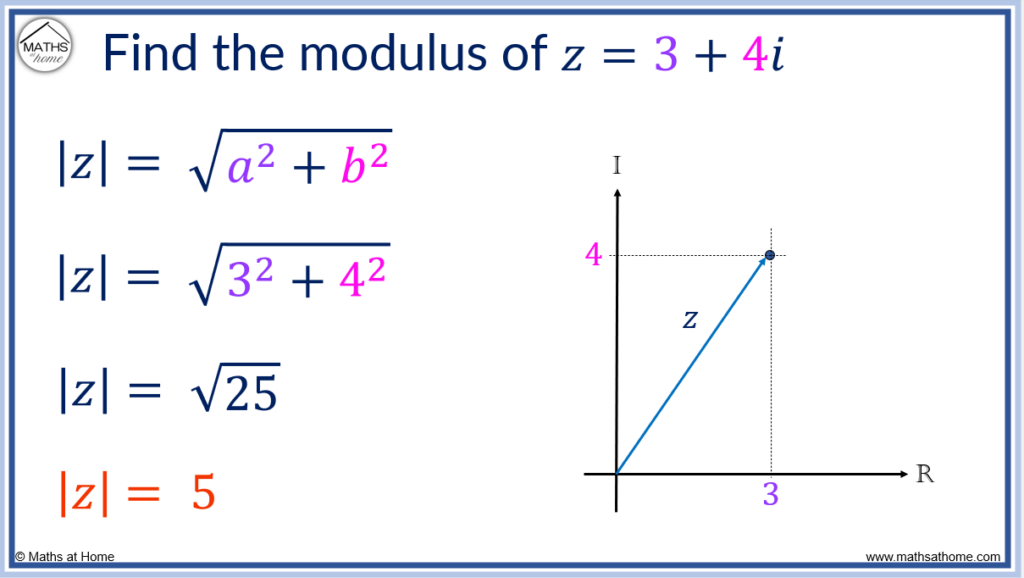
To calculate the modulus of a complex number in steps:
- Square the size of the real part of the complex number.
- Square the size of the imaginary part of the complex number.
- Add the two results together.
- Square root this result.
For example: Find the modulus of z = √3 + i.
Step 1. Square the size of the real part of the complex number
The real part of is the part without an i.
That is, the real part is √3.
Squaring this, .
Step 2. Square the size of the imaginary part of the complex number
The imaginary part of is the part with the i.
That is, the imaginary part is just i, which is the same as 1i.
The size of the imaginary part is 1.
Squaring this, .
Step 3. Add the two results together
3 + 1 = 4
Step 4. Square root this result
and so, the modulus is
.

The following table contains some examples of calculating the modulus of a complex number:
| Complex Number | Modulus Calculation | Modulus |
| z = 1 + 3i | √(12 + 32) | √10 |
| z = 1 + i | √(12 + 12) | √2 |
| z = -1 + 5i | √( (-1)2 + 52) | √ |
| z = i | √(12) | √1 |
| z = -2i | √( (-2)2 ) | √2 |
How is the Modulus of a Complex Number Used?
Some of the most common uses of the modulus in mathematics, physics and engineering include:
- Calculating the distance from the origin: The modulus of a complex number is the distance of the number from the origin on the complex plane. It can be used to calculate the distance between two complex numbers.
- Writing the polar form of a complex number: The modulus of a complex number is used to express the number in polar form, where the modulus is the magnitude or radius and the argument is the angle the complex number makes with the positive x-axis.
- Writing the modulus-argument form of a complex number: The modulus and argument of a complex number can be used to represent the complex number in modulus-argument form.
- Complex Amplitude: In signal processing and physics, the modulus of a complex number can be used to represent the amplitude of a signal.
- Inverse trigonometric functions: The modulus of a complex number is used when finding the inverse trigonometric functions of complex numbers, which is useful in physics and engineering.
- Determining the stability of a system: In control systems, the modulus of a complex number can be used to determine the stability of a system.
Properties of the Modulus of a Complex Number
The following are some key properties of the modulus of a complex number:
- The modulus of a complex number is a non-negative real number. This means that the modulus will always be greater than or equal to zero. That is,
.
- If the modulus of a complex number is zero, then the complex number is z = 0.
- The modulus is commutative for multiplication and division. That is,
and
.
- The modulus of a complex number is invariant under rotation of the complex plane. This means that the modulus does not change when the complex number is rotated in the complex plane.
- The modulus of a complex number is equal to the modulus of its conjugate. This means that the modulus of a + bi is the same as the modulus of a – bi. That is,
and
.
- Triangular inequality: The modulus of a complex number satisfies the triangle inequality, which states that the sum of the absolute values of any two complex numbers must be greater than or equal to the absolute value of their sum. That is,
.
- The modulus of a complex number raised to a power is equal to the modulus of the complex number raised to that power. That is,
.
- The square of the modulus of a complex number is equal to the difference between the complex number and the conjugate of the complex number. That is,
.
- If a complex number has a modulus of 1, that is |z|=1, then it is known as unimodular.
What is the Argument of a Complex Number?
The argument (also known as the phase or amplitude) of a complex number is the angle that the vector representing the number makes with the positive real axis in the complex plane. It is typically denoted by the Greek letter “phi” (φ) measured in radians between the interval –π and π.
The argument of a complex number can be written as arg(z) for short.
The argument is always measured from the positive real axis, which is the right facing direction.
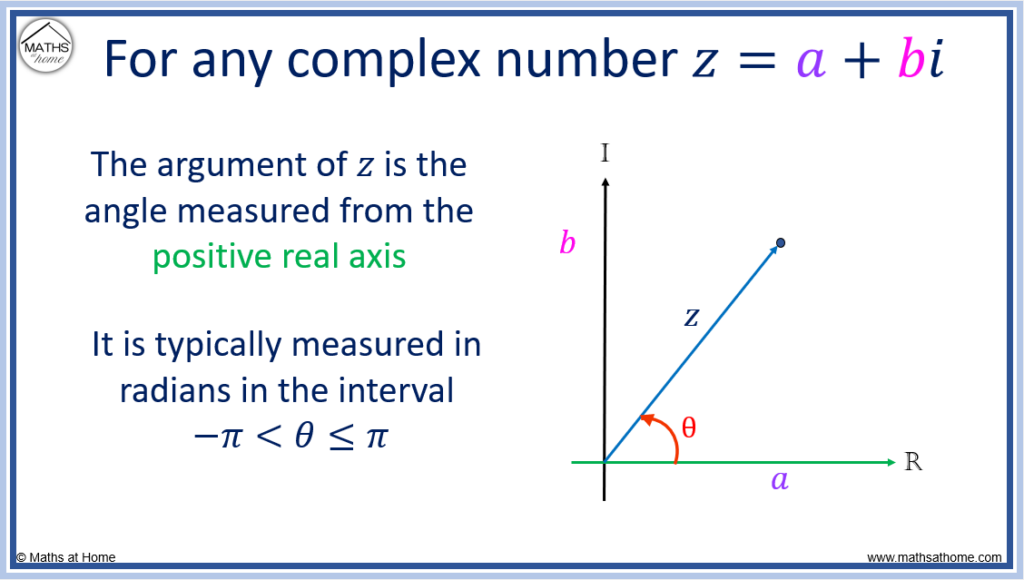
The argument of a complex number is periodic with a period of 2π. Therefore the general argument of a complex number is represented by θ + 2πk.
The principal argument of a complex number is defined as the angle measured from the positive real axis, taking values in the interval –π ≤ θ ≤π.
Angles measured from the positive real axis in the counter-clockwise direction are positive.
Angles measured from the positive real axis in the clockwise direction are negative.
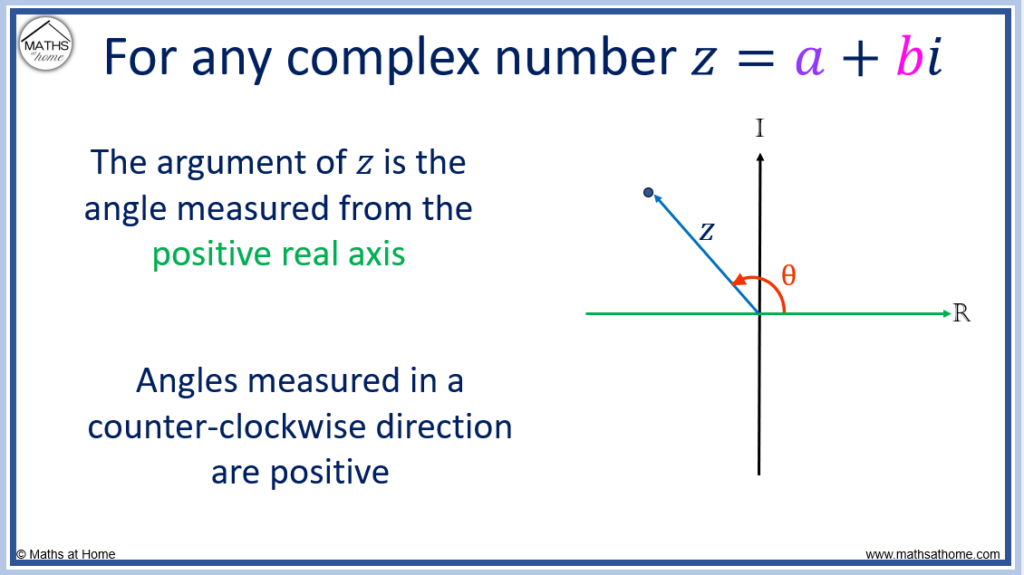
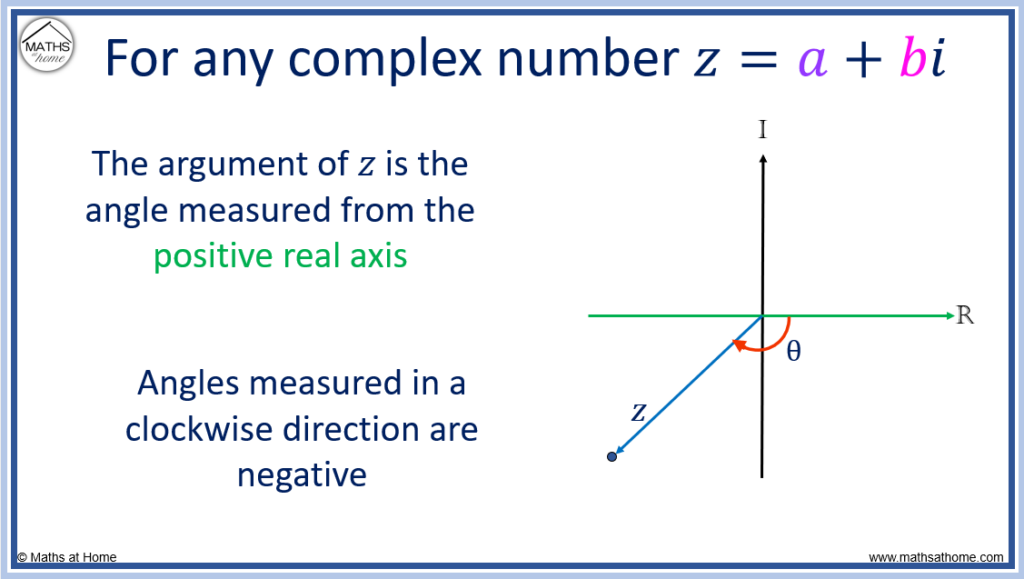
How to Find the Argument of a Complex Number
To calculate the argument of a complex number z=a+bi:
- First calculate θ=tan-1(b/a).
- If the complex number is in quadrant 1, the argument is equal to θ.
- If the complex number is in quadrant 2, the argument is equal to π+θ.
- If the complex number is in quadrant 3, the argument is equal to θ-π.
- If the complex number is in quadrant 4, the argument is equal to θ.
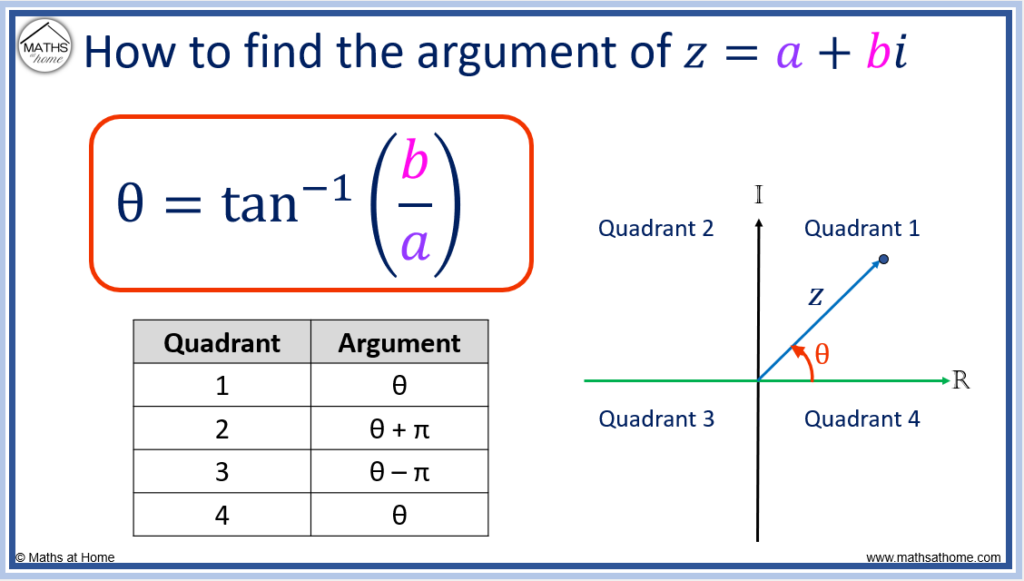
For example, find the argument of .
Step 1. First calculate θ=tan-1(b/a)
‘a’ is the size of real part of the number and ‘b‘ is the size of the imaginary part of the number.
In the complex number, :
Therefore becomes
and so,
.
Step 2. The complex number is in quadrant 1 and the argument is equal to θ
Since the complex number is in quadrant 1 of the argand diagram, the argument is equal to θ.
Therefore, .
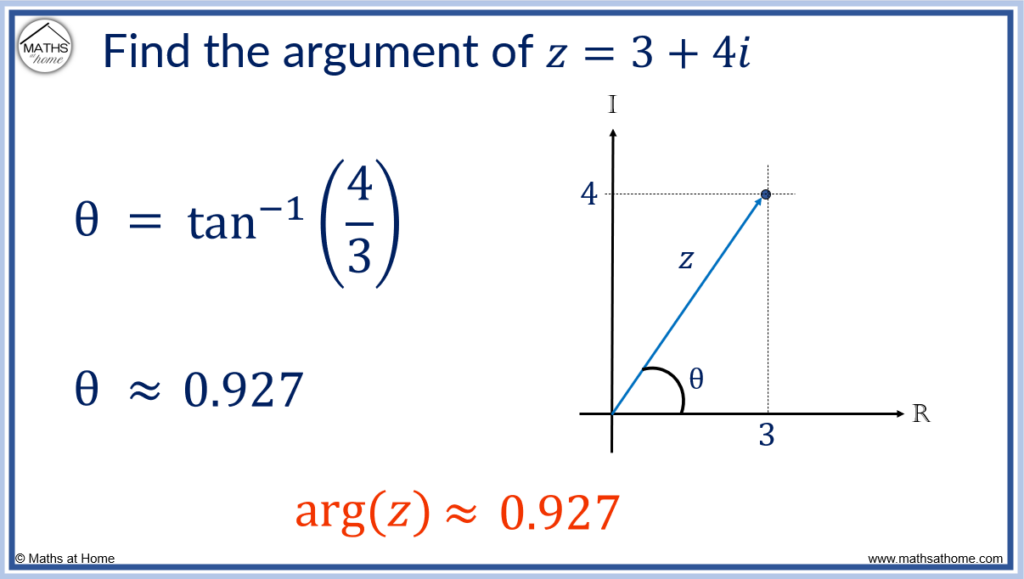
Example of calculating the argument of a complex number in the third quadrant:
The complex number is in the third quadrant as shown in the argand diagram below.
The argument is shown by the angle θ, which is a negative angle measured clockwise from the positive real axis.
Step 1. First calculate θ=tan-1(b/a)
‘a’ is the size of real part of the number and ‘b‘ is the size of the imaginary part of the number.
In the complex number,
Therefore becomes
and so,
.
Step 2. The complex number is in quadrant 3 and the argument is equal to θ–π
The argument is the nearest angle to the complex number direction as measured from the positive real axis (from the right).
Since the complex number is in the third quadrant, the argument is calculated as θ – π.
and so,
.
Therefore the argument is given by .
The argument of a complex number is negative when the nearest angle to the direction of the complex number from the positive real axis is clockwise.
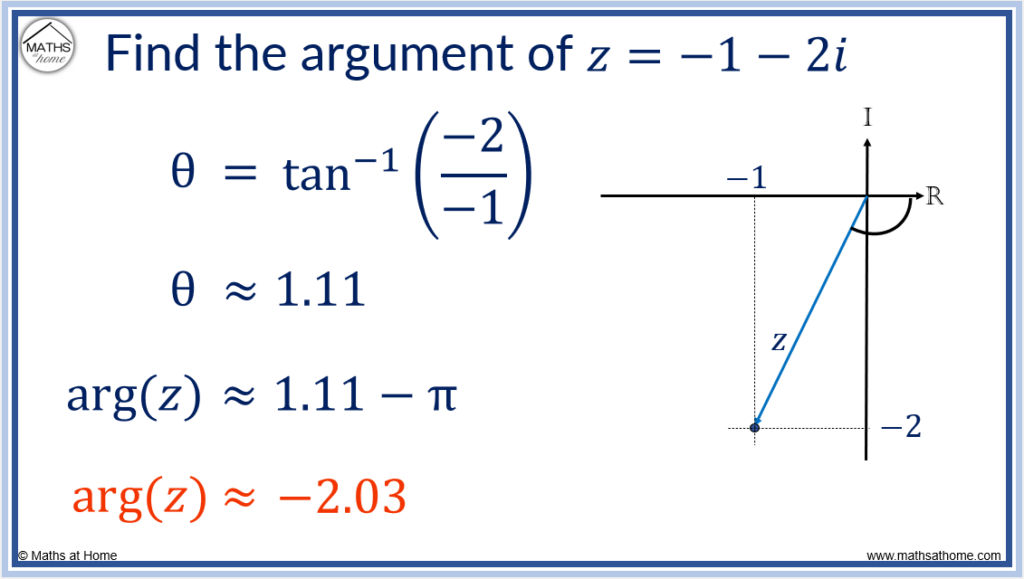
Here are some further examples of calculating the argument of a complex number.
The argument is calculated using the following rules:
For a complex number , the angle
.
- If the complex number is in quadrant 1, the argument is equal to θ.
- If the complex number is in quadrant 2, the argument is equal to π+θ.
- If the complex number is in quadrant 3, the argument is equal to θ-π.
- If the complex number is in quadrant 4, the argument is equal to θ.
| Complex Number | Quadrant | θ Calculation | Argument Calculation |
| -1-i | 3 | arctan(-1/-1) = π/4 | π/4 – π = -3π/4 |
| 1-√3i | 4 | arctan(-√3/1) = –π/3 | –π/3 |
| 3-√3i | 4 | arctan(-√3/3) = –π/6 | –π/6 |
| 1+√2i | 1 | arctan(2/1) = 0.955 | 0.955 |
| -1+i | 2 | arctan(1/-1) = –π/4 | -π/4 + π = 3π/4 |
Here are some examples of complex numbers with no real part
- z=i has an argument of π/2
- z=-i has an argument of –π/2
These arguments cannot be calculated using arctan since their real component is zero.
Any complex number that has no real part will lie on the imaginary axis.
If it is a positive complex number, it will be located on the imaginary axis above the real axis and so, its argument will be π/2.
If it is a negative complex number, it will be located on the imaginary axis below the real axis and so, its argument will be -π/2.
Modulus and Argument of a Complex Number Written in Exponential Form
For a complex number written in the exponential form as z = Reiφ, R is the modulus and φ is the argument. For example, if z = 3eπi, the modulus is equal to 3 and the argument is equal to π.
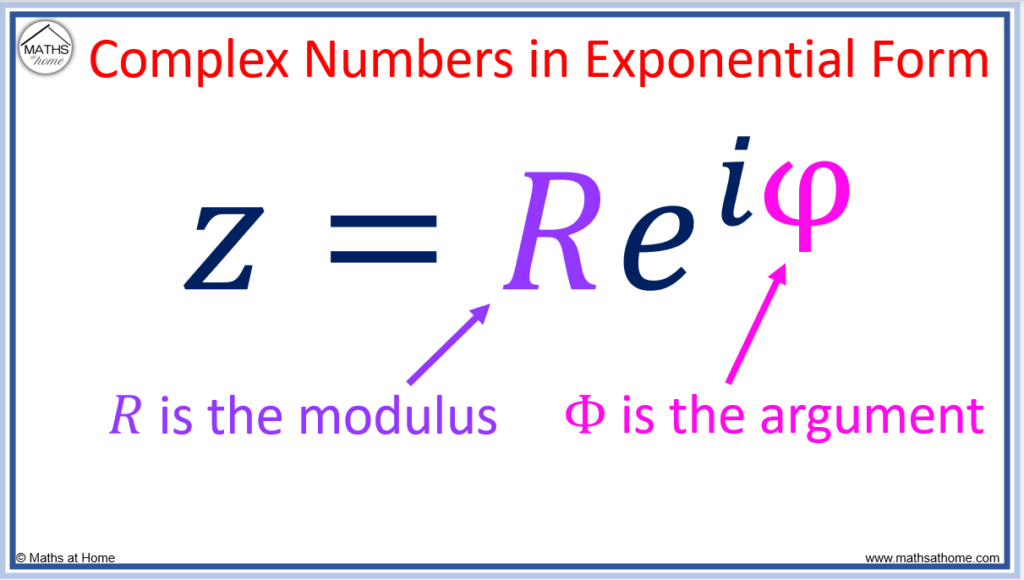
The exponential form of a complex number is an easy way to view the modulus and argument.
The modulus is the coefficient of the exponential in front of Euler’s number.
The argument is alongside i in the power of the exponential.

Modulus and Argument of a Complex Number Calculator
This calculator will calculate the modulus and argument of a complex number.
Simply enter the real part and imaginary part of the complex number in the calculator below.
That is, for any complex number , where a is the real part and b is the imaginary part.
For example, in the complex number , the real part is
and the imaginary part is -1 because there are -1 lots of i.
